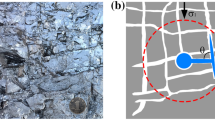Abstract
Underground coal fires (UCFs) constitute severe disasters, yet the quantification of the process of coal fire propagation, the first step in knowing how to extinguish a UCF, remains a great challenge even after decades of research. An important feature for understanding oxygen supply to a coal fire is the permeability of the UCF zone. Here, we propose a model for a typical UCF zone based on an analysis of the deformation of the overlying rocks caused by the UCF. We delineate the physical boundaries of the UCF and show how the zone includes both porous media and fractured zones. We then attempted to quantify the permeability of these porous and fractured zones and use the quantitative model to design, build, and employ an elementary UCF air/smoke flow experimental apparatus to run a permeability experiment. Subsequent to the experiments, we used simulation software to build a numerical model of the experimental apparatus. Calculated results from the numerical model agreed reasonably well with results from the physical experiments, though for this model to be applied in practice to quantify UCF propagation, further research on problems such as the size and distribution of the fractures and the relationship between the fractures and stress in the rock matrix will be required.










Similar content being viewed by others
References
Cao D, Fan X, Wu C (2009) Study on the fractures related with coalfield fire area in Wuda coalfield, Inner Mongolia. J China Coal Soc 34:1009–1014 (in Chinese)
Chatterjee RS (2006) Coal fire mapping from satellite thermal IR data—a case example in Jharia Coalfield, Jharkhand. ISPRS J Photogramm Remote Sens 60:113–128
Collins RE (1961) The flow of fluids through porous materials. Reinhold Publishing Corporation, New York
Huang JJ, Bruining J, Wolf KAHH (2001) Modeling of gas flow and temperature fields in under-ground coal fires. Fire Saf J 36:477–489
Ide TS, Pollard D, Orr FM Jr (2010) Fissure formation and subsurface subsidence in a coal bed fire. Int J Rocks Mech 47:81–93
Jia M, Guo W, Chen J (2000) Analysis on the type and feature of non-continuous deformation and damage of ground surface. J Jiaozuo Inst Technol 19:278–280 (in Chinese)
Kuenzer C, Zhang J, Tetzlaff A et al (2007) Uncontrolled coal fires and their environmental impacts: investigating two arid mining regions in north-central China. Appl Geogr 27:42–62
Nolter MA, Vice DH (2004) Looking back at the Centralia coal fire—a synopsis of its present status. Int J Coal Geol 59:99–106
Pone JDN, Hein KAA, Stratcher GB et al (2007) The spontaneous combustion of coal and its by-products in the Witbank and Sasolburg coalfields of South Africa. Int J Coal Geol 72:124–140
Renard P (1997) Calculating equivalent permeability: a review. Adv Water Resour 20:253–278
Song Z, Kuenzer C (2014) Coal fires in China over the last decade: a comprehensive review. Int J Coal Geol 133:72–99
Song Z, Zhu H, Tan B, Wang H, Qin X (2014) Numerical study on effects of air leakages from abandoned galleries on hill-side coal fires. Fire Saf J 69:99–110
Stracher GB, Taylor TP (2004) Coal fires burning out of control around the world: thermo dynamic recipe for environmental catastrophe. Int J Coal Geol 59:7–17
Stracher GB, Prakash A, Sokol EV (2011) Coal and peat fires: a global perspective. Elsevier, Oxford
Whitehouse AE, Mulyana AAS (2004) Coal fires in Indonesia. Int J Coal Geol 59:91–97
Wolf K-H, Bruining H (2007) Modelling the interaction between under ground coal fires and their roof rocks. Fuel 86:2761–2777
Xu Y (2003) Mining mothodology. China University of Mining and Technology Press, Xuzhou (in Chinese)
Yuan L, Smith AC (2008) Numerical study on effects of coal properties on spontaneous heating in longwall gob areas. Fuel 87:3409–3419
Zeng Q (2012) Study on the thermal dynamic characteristics of combustion system for coal fires in Xinjiang region. PhD Thesis, China University of Mining and Technology (in Chinese)
Zeng Q, Chang X (2007) Study on the model of fire-heating airflow and its application to Xinjiang Coalfield fires. J China Coal Soc 32:955–958 (in Chinese)
Zhang D, Bai S, Yang C (2003) Analysis and study on permeability of fractured rock mass. Site Investig Sci Technol 1:24–27 (in Chinese)
Acknowledgments
This research was supported by the Nature Science Foundation of Xinjiang Local Government of China (Project Nos.: 2011211A106, 2014211A051) and the Nature Science Foundation of China (NSFC) (Project Nos.: 51164032, 51374182).
Author information
Authors and Affiliations
Corresponding author
Rights and permissions
About this article
Cite this article
Zeng, Q., Tiyip, T., Wuttke, M.W. et al. Modeling of the equivalent permeability for an underground coal fire zone, Xinjiang region, China. Nat Hazards 78, 957–971 (2015). https://doi.org/10.1007/s11069-015-1752-4
Received:
Accepted:
Published:
Issue Date:
DOI: https://doi.org/10.1007/s11069-015-1752-4




